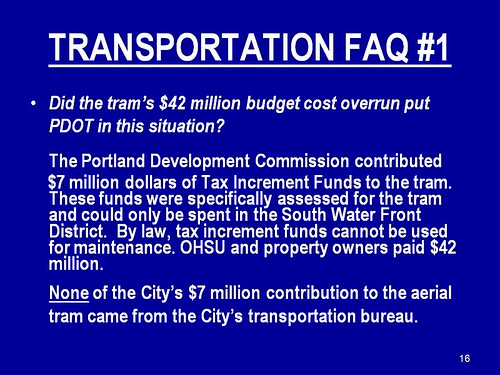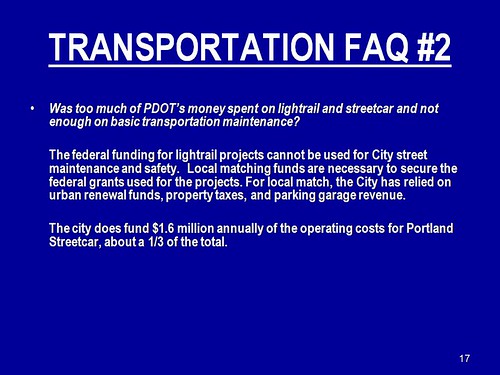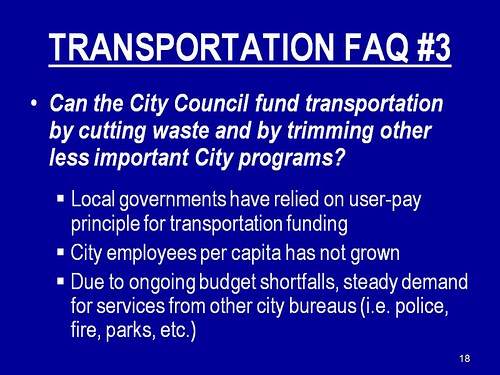This is the second in our series on Commissioner Adams’ efforts to develop a sustainable funding stream for maintaining Portland’s streets. Today we look at dispelling some of the myths and misconceptions about local transportation funding. Sam gets these questions so often that he built an FAQ section into his presentation.
More after the break.
No question that maintenance isn’t sexy, but it’s important. In the next post in the series, we’ll look at ways we might fund it.





25 responses to “Maintaining Portland’s Streets: Myth Busting”
I was told by a source within PDOT that street franchise fees (paid by utilities) were shifted from PDOT to the general fund about 8 or 10 years ago. Can someone confirm?
Not sure of the amount, but I would think it would be real dollars. Why not get it shifted back, if street maintenance is that worthy a need. Seems logical…oh that’s probably why it will never happen.
Transportation FAQ #1 – Although the seven million dollars of tax increment funding could not be used for street maintenance, it could have been used for new/improved streets, roads and other transportation projects within the South Waterfront District.. It should also be noted that tax increment funding comes from property taxes within the South Waterfront Urban Renewal District that are redirected to capitol projects rather than going to schools and the general fund that supports, police, fire, parks, ect. Therefore, the rest of Portland property tax payers must subsidize these services for the South Waterfront and other urban renewal districts.
Transportation FAQ #2 & 3 – If streetcar operations were more financially self-sustainable and the City of Portland did not contribute a 1.6 million dollar annual subsidy to keep the wheels turning, funds from motorist paid parking garage and meter revenues could be made available for things like street maintenance. Furthermore, the city may also be on the hook to subsidize one-third of the 5.6 million dollar operational subsidy for the proposed Eastside Streetcar. Again, a large sum of money to subsidize a small percentage of Portland citizens that would use it.
Transportation FAQ #4 – Not mentioned is the amount PDOT money spent to subsidize bicyclists with more bicycle infrastructure, and the amount of local match funds spent on making streets pretty and creating more congestion with curb extensions instead of funding street maintenance and making roadways more functional – able to handle more vehicle capacity rather than less.
(S)treet franchise fees (paid by utilities) were shifted from PDOT to the general fund about 8 or 10 years ago… Why not get it shifted back(?) Seems logical…oh that’s probably why it will never happen.
The answer would probably be something like ‘less money for parks, affordable housing, water bureau (oh, wait… meh, they probably have the most oversight right now),’ or some other white elephant.
Terry, I agree with you about the $7M for the Tram, it could have been spent on other transportation infrastructure within the district. On the other hand, I’m not sure there would be a district without the Tram. OHSU certainly would not be expanding its campus into the district.
On the rest, we don’t agree at all. The incremental parking revenue WOULD NOT EXIST without the Streetcar. The business community would not have bought into the increase in rates.
And as to the bike lanes and curb extensions, I think it depends what kind of district you want to live in. The folks buying homes in the district seem to think they’re amenities. If your idea of an amenity is an auto-dominated area like 82nd Avenue, by all means, feel free to enjoy it. It’s not my cup of tea, and I think most folks in the City are closer to my view than yours.
I really get tired of hearing about how bicyclists are subsidized.
Bicyclists pay taxes, just the same as those who drive cars. Many also own cars, but choose to ride their bikes so that they can be healthier, friendlier to the environment, and take one more car off the road.
Apparently studies show the most heavily subsidized form of transportation is a vehicle with one person in it. And having driven into Portland many times during rush hour, that accounts for a huge chunk of the commuters on the roads.
Bicyclists pay taxes, just the same as those who drive cars. Many also own cars, but choose to ride their bikes so that they can be healthier, friendlier to the environment, and take one more car off the road.
So do pedestrians for that matter, but not children (unless they work). So do we argue that schools are unfairly subsidized because those who use it don’t pay – and therefore reallocate those dollars towards, say, tennis courts and golf courses? Or more police?
Back to bikes and whether they pay taxes or not – there is no tax – NO tax – assessed on the sale, purchase, upkeep, maintenanace, or use of a bicycle. Not one. Yes, bicyclists might pay property taxes (which go towards all kinds of things, including bike paths, schools, fire departments, the Mayor’s office, TriMet, the airport, dog control) – but bicyclists do NOT pay any fee to ODOT or the maintenance of state highways, bike paths, etc.; nor do they pay into the Federal Highway Trust Fund.
Even if the argument holds that “they drive sometimes”, that the taxes derived from the tmes they drive go to support the use of that motor vehicle and not how the taxpayer sees fit. If bike/drivers are allow to segregate how their tax dollars go, I find it ironic that they feel that others should not bear the same right to choose where their taxdollars go. I’m sure many motorists would say “to hell with TriMet” and demand 100% of their highway dollars go towards highways. Fair is fair – if you want your gas taxes to selectively go towards bike improvements, others should have the right and fair say as to how their taxdollars are being spent.
With regards to Oregon’s gas tax, it’s already been done (Article 9, Section 3A, Oregon Constitution, adopted by the people November 2, 2004).
“Back to bikes and whether they pay taxes or not – there is no tax – NO tax – assessed on the sale, purchase, upkeep, maintenanace(sp), or use of a bicycle.”
There is also no tax on anything related to shoes, which most people use for walking, (although you could always get around it by not wearing shoes in the first place.) I’ve also noticed that there are a lot of people that wear shoes until they fall apart, and people that wear shoes like that tend to walk a lot more compared to people that just buy a pair of shoes and then only use them a couple of times. Clearly the “shoe tax” should be set up so that fancy dress shoes would pay less, and hiking boots that will last forever show pay more…
And PDOT spends a lot more on pedestrians than they do on bicycles, why don’t we go after the bigger problems first?
I can’t think of a single good reason to increase the cost of riding a bike instead of driving a car.
I can’t think of a single good reason to increase the cost of riding a bike instead of driving a car.
When ODOT’s budget (and City of Portland Parks & Rec) gets pared down and the bike paths go into disrepair, will bicyclists be willing to pay for their infrastructure then – or will they demand that someone else pay for it?
When ODOT’s budget (and City of Portland Parks & Rec) gets pared down and the bike paths go into disrepair, will bicyclists be willing to pay for their infrastructure then – or will they demand that someone else pay for it?
If it is still beneficial to society as a whole to encourage people to use their bicycles, as opposed to more expensive or harmful modes of transportation, there is no reason not to expect society to shoulder some, if not all of the cost. For that matter, if ODOT’s budget is ever pared down that much, it should focus on the lowest cost modes: bicycling and walking, as opposed to relatively extravagant auto and rail projects.
“If your idea of an amenity is an auto-dominated area like 82nd Avenue, by all means, feel free to enjoy it. It’s not my cup of tea, and I think most folks in the City are closer to my view than yours.”
>>>> Auto-dominated? Well, not completely, by a long shot. #75 is the heaviest bus line in all of Trimet, with excellent service levels (except for the lack of limiteds). #14, 9, 4, 15, MAX, and #12 are all frequent service lines that have stops at 82nd. The sidewalks on 82nd are decent enough in width for the most part. The renovated Eastport Plaza has excellent pedestrian access.
As a non-driver, I really have no substantial complaints about 82nd from my perspective. I still take the #17 from the NW District out there once in a while to do some “generic” eating or shopping.
And I really wonder how many of the transit-sympathetic progressives in this town drive their cars out to places in Wash. County or Mall 205 to shop in big-box stores. Hmm?
I think that most of the people in Portland still drive cars and shop in chain stores. Sorry, Chris.
Nick wrote: “Auto-dominated? Well, not completely, by a long shot. #75 is the heaviest bus line in all of Trimet…”
“Auto-dominated” does not mean “without transit”.
82nd is about as auto-dominated as you’ll find within the city limits of Portland, except for freeways: Heavy auto traffic, curb-flush sidewalks (without street parking in most places), long distances between protected pedestrian crossings, and very little signal preemption or queue jumping for transit.
– Bob R.
PS… I think you mean the #72. The #75 runs on 39th and on Lombard, not 82nd.
The 72 does indeed have a high level of boardings — 17,282 average weekday boardings in FY2006.
The route of the #72 is approximately 18.5 miles in length. This means the #72 receives an average of 934 boardings per route mile.
Compare that to the MAX Yellow Line, TriMet’s shortest MAX route: With over 13,000 weekday boardings along 5.5 miles, that’s 2,363 boardings per route mile, over 2.5X greater ridership density than the #72.
Or, compare to the Portland Streetcar: 9,800 average daily boardings (Spring, 2007) over 3.6 route miles, or 2,722 boardings per route mile — almost 3X the ridership density of the #72.
My point? You’ve frequently characterized the Portland area as a region where rail service is completely inappropriate for the population density… yet even the smallest rail projects in the region support several times the ridership of the most heavily used bus line — a bus line which you have characterized as having “excellent service levels”. If an “excellent” bus line fails to attract even a third of the ridership as the streetcar, perhaps you shouldn’t be so quick to rule out other modes for certain corridors.
– Bob R.
I am crossposting my reply here:
I was talking about the portion of the #72 that runs along 82nd–it seems to be much more heavily travelled than the portion that runs along Killingsworth to Swan Island. (I actually RIDE these things.) I understand that the route as a whole operates at a PROFIT! (unlike the streetcar, which requires a subsidy). And the service levels ARE excellent: 10 min. base and SATURDAY headways. 6-8 mins. in the PM and 15 min. to after 10 PM.
And it is not a fair comparison to the streetcar:
1) The streetcar is so hyped to death so the tourists think it’s cute; nobody ever hyped the #72. 2) Practically no one pays on the streetcar–Fareless Sq. or no–so how can you compare a route where almost everyone rides for free to a route where EVERYONE pays? People will jump on the streetcar to ride for a few blocks instead of walking. A bus line would have provided basic transportation without the fluff, and without the fare evasion past Fareless Square.
And while it’s true that there has been a spike recently in ridership along I-MAX, I have a sneaky feeling that there is rampant fare evasion in that neck of the woods–when people realize that they don’t have to pay to ride MAX as compared to the bus….
I think that “profit” argument for individual buses is a bit of a myth. Without the rest of the system most bus routes would not have many riders. Its like arguing that the seats next to the windows on a bus are more profitable than aisle seats. You really need to look at the system as a whole.
Nick –
Please see my reply to you over on the rapid streetcar thread.
– Bob R.
I am a conservative solo auto commuter who rarely rides a bike and I fully support these so-called “bike subsidies” — it is microscopic, and it is one of the best investments we can make in our community going forward. Surely there are (a trillion?) better things to focus on in terms of misallocations of public funds than this.
Bikes cause congestion and increase polution.
For example, I have been behind a bike on the St. Johns bridge that had at least two dozen cars backed up behind it for at least 5 minutes. Many of those cars were older models that create tons more polution than newer models. That is 120 minutes of engines running and producing polution (and 120 minutes of people’s time lost forever) so that bike rider could save the polution caused by 10 minutes of driving.
Now multiply this scenerio many times every day throughout the city and see that bikes indeed do harm.
I have been behind a bike on the St. Johns bridge
If ODOT had striped bike lanes on the bridge (which their own consultant said would not reduce auto/truck capacity because the actual bottlenecks are at the bridgeheads) you would not have had this problem.
I have been behind a bike on the St. Johns bridge that had at least two dozen cars backed up behind it for at least 5 minutes.
Five minutes? Was he walking his bike across in a traffic lane?
“I have been behind a bike on the St. Johns bridge that had at least two dozen cars backed up behind it for at least 5 minutes.”
It is a four lane bridge, two lanes in each direction. Why, exactly, didn’t you pass in the other lane?
And I have to echo Chris’s statement, the congestion tends to be at the traffic lights at the ends, the bridge itself tends to be fairly empty.
you are missing the point, are you all contending that bikes NEVER slow auto traffic?
you are missing the point, are you all contending that bikes NEVER slow auto traffic?
Not at all, but are you contending that bicycle infrastructure never helps auto traffic?
The example you gave was from a facility with no bicycle infrastructure.
For example, a fantastic piece of future bicycle infrastructure might be the proposed multi-use path along I-84, from the Gateway area all the way to Rose Quarter. This would allow many people to safely commute by bike, with a good travel time, who would otherwise drive or would be riding along streets like Glisan, Halsey, Burnside, Sandy, etc.
– Bob R.
you are missing the point, are you all contending that bikes NEVER slow auto traffic?
Then why not provide a plausible real-world example that doesn’t involve a dozen motorists who all inexplicably refuse to change lanes to pass a 5 mph cyclist taking up one lane on a four-lane bridge? That kind of absurd example makes it easy to disregard any other point you want to make.
It is true that traffic congestion wastes time and causes pollution, but the VAST majority of traffic congestion is caused by cars. Get most of the cars off the road at rush hour, and congestion will almost completely disappear.
NWJG:
When I bike on narrow streets with no dedicated bike lanes (or say, for example, the St. John’s bridge) I will bike in the middle of my lane. I do this not only due to personal safety concerns, but also as this is the official recommendation from the Oregon Department of Transportation.
If you are concerned about bicycles creating congestion, an obvious and logical solution would be to advocate for more bike lanes. I’ll ignore the extra lane dilemma that others have pointed out, but allowing bikes to have dedicated travel lanes would reduce situations like what you describe above.
Otherwise, considering that, under Oregon State Law, bicycles are considered vehicles and thus share all the same rights and obligations of automobile traffic, I will continue to ride in such a way that ODOT recommends.